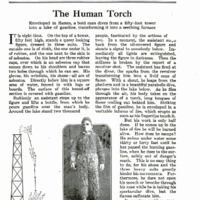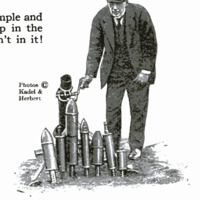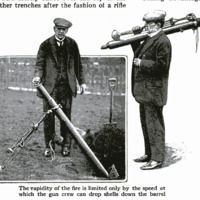British Stokes gun
Item
-
Title (Dublin Core)
-
British Stokes gun
-
Article Title and/or Image Caption (Dublin Core)
-
Outdoing the Mine Throwers. Stokes gun used by British proves simple and effective in trench warfare. You drop in the shells. German "Minenwerfers" aren't in it!
-
extracted text (Extract Text)
-
A WEAPON with little velocity but
which could heave considerable
quantities of high explosive into an
enemy trench, was badly needed at the
beginning of the war. The Germans were
the first in the field. Hans worked out
little trench mortars he called minenwer-
fer. Soon the British replied with the
Stokes gun. This latter is now linked
with the famous Lewis machine gun, the
Mills and Hale grenades, and the like, as
one of the most potent inventions brought
about by the war.
Trench mortars and howitzers are
merely short-barreled, light-shell pitch-
ing guns used for sending shells via the
indirect fire route from one trench, over
Deadman’s land, to another trench. High
velocity would defeat its own purpose,
just as would direct fire. One would drive
the shell entirely too far when the gun
was elevated to pitch the shell, the other
would merely shoot over the top of the
other trenches after the fashion of a rifle
bullet. In consequence, a mortar of any
sort is elevated to not less than a 45-
degree angle. This causes a shell to go
skyward and over toward the other
fellow like a deceased cat over your alley
fence. The method is simple. It is
effective none the less.
Taking advantage of the fact that a
bullet. In consequence, a mortar of any
sort is elevated to not less than a 45-
degree angle. This causes a shell to go
skyward and over toward the other
fellow like a deceased cat over your alley
tence. The method is simple. It is
effective none the less.
Taking advantage of the fact that a
elevated at an
angle of 45 de-
grees or more
from the hori-
zontal, Wilfred
Stokes worked
out a shell, con-
sisting of a case
containing a large *
quantity of high ex-
plosive, fitted to a
base filled with a
light charge of pro-
pellant powder—also
a primer therefor.
The bottom of the
gun barrel has a pro-
jection or stud in-
side. So when this
new shell is dropped
down the barrel of
the gun from the
muzzle, the fall
bangs the primer
against this stud and
sets off the gun.
-
Contributor (Dublin Core)
-
Wilfred Stokes (inventor)
-
Kadel & Herbert (photos)
-
Language (Dublin Core)
-
eng
-
Date Issued (Dublin Core)
-
1918-01
-
pages (Bibliographic Ontology)
-
39
-
Rights (Dublin Core)
-
Public Domain (Google digitized)
-
Archived by (Dublin Core)
-
Filippo Valle
-
Alberto Bordignon (Supervisor)
 Popular Science Monthly, v. 92, n. 1, 1918
Popular Science Monthly, v. 92, n. 1, 1918





